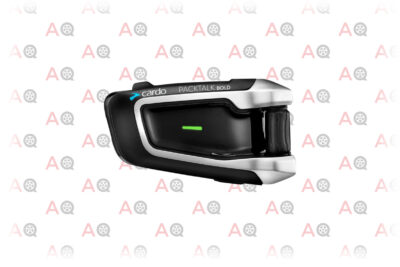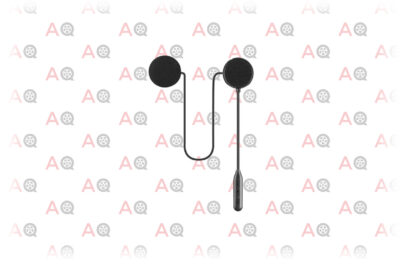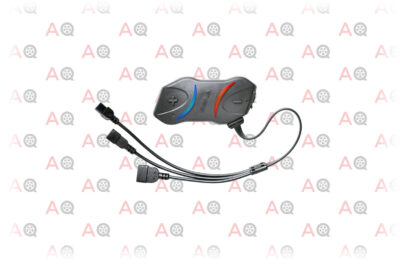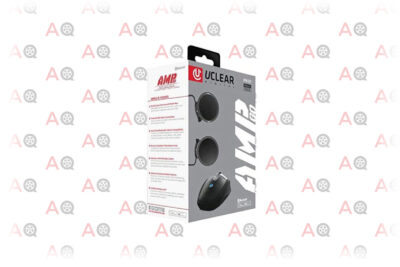There’s very little that beats the feeling of riding your motorcycle, hearing the engine roar, and feeling that barely-contained power devour miles of tarmac underneath you.
While it’s a formula that’s hard to improve, there are a couple of ways to make it better. The main thing? Listening to music or joking and chatting with riding buddies. That’s where helmet speakers come in.
- What Are Motorcycle Helmet Speakers?
- Why You Need a Motorcycle Helmet Speaker
- Top 10 Best Motorcycle Helmet Speakers 2025
- 1. Best Overall Motorcycle Helmet Speaker: Cardo DMC Packtalk Bold
- 2. Best Premium Motorcycle Helmet Speaker: Sena SMH10-10
- 3. Best Weather Resistant Motorcycle Helmet Speaker: Outdoor Technology The Chips 2.0
- 4. Lexin LX-B4FM Motorcycle Intercom
- 5. Best Budget Motorcycle Helmet Speaker: JZAQ Bluetooth 5.0 Motorcycle Helmet
- 6. Toughest Motorcycle Helmet Speaker: Alta Wireless Drop In Headphones
- 7. Best Non-iPhone Motorcycle Helmet Speaker: UClear Digital Pulse Plus
- 8. Best Slimline Motorcycle Helmet Speaker: Sena SMH10R Low Profile Headset and Intercom
- 9. Best Noise-Canceling Motorcycle Helmet Speaker: Thokwok BT-S3 Helmet Headphones
- 10. Best Motorcycle Helmet Speaker for Multiple Users: UClear AMP Go
- Buying the Best Motorcycle Helmet Speakers
- Final Thoughts
What Are Motorcycle Helmet Speakers?
As the name suggests, bike helmet speakers are a set of speakers or headphones that are designed specifically to be used in your motorbike helmet when you ride.
It stands to reason that you should never use conventional headphones when riding your bike. It’s just not safe. Unlike standard headphones, helmet speakers have several features that make them much better to use on the road.
Why You Need a Motorcycle Helmet Speaker
Not only will a simple motorcycle helmet speaker keep you entertained with music, podcasts, or radio during long highway hauls, it can also serve safety purposes. Entertainment is proven to help keep motorcyclists awake by preventing tiredness. Helmet communication and intercom systems can also help keep motorcyclists safe and informed.
Listening to Music
Helmet speakers are perfect for listening to music as you ride. Unlike standard headphones, specific motorbike speakers have dedicated technology in them that makes listening much simpler, including:
- Noise-canceling technology
- Volume boosting that responds to engine noise
- Simple controls that can be used even when wearing heavy riding gloves
GPS
Almost all phone-based GPS programs have the option for voice directions. Rather than having to look down at your phone to check which turns to take, headphone speakers deliver them straight to your ear, making it that much more difficult to get lost.
Hands-Free Operation
Using a phone while on a motorbike is an incredibly risky proposition. While it might be legal to use a phone secured in a bike-mounted cradle in some states, we wouldn’t recommend it, as the dangers far outweigh the advantages of just stopping to make the call.
If you take calls or need to listen to turn-by-turn directions when riding and need the option to safely answer, helmet speakers let you manipulate your device completely hands-free, so you can keep your hands where they need to be and your attention on the road.
Inter-Rider Communication
Riding with other people is common, especially if you ride for pleasure over transportation. Better motorcycle helmet speakers have built-in Bluetooth intercom communication systems, letting you link speakers and talk to your riding buddies completely hands-free.
Top 10 Best Motorcycle Helmet Speakers 2025
1. Best Overall Motorcycle Helmet Speaker: Cardo DMC Packtalk Bold

Editor’s Rating:
Cardo has been making helmet speakers for as long as they’ve existed and their years of development are easy to see in these speakers. The Packtalk is literally one of the best helmet speakers on the market right now, especially if you run in large groups.
First off, the sound quality is exceptional, because it comes through 40mm JBL drivers. JBL is one of the world’s best-known speaker manufacturers, which is why the clarity is fantastic. A high max volume is loud enough to overpower high speeds and big engines. The volume is also self-adjusting, automatically scaling up as background noise increases.
It’s simple to control, either with the big buttons, or with voice activation. The Packtalk has built-in Natural Voice, which activates when it hears you speak, and the main controls can be accessed through voice commands, for example, saying ‘Hey Cardo, music on,’ starts the tunes.
The Packtalk has a best in class intercom which uses something called Dynamic Mesh Communication. Normal Bluetooth networks use a linear system, meaning that every person is connected to two more, like a chain. Obviously, this means if someone loses connection, it breaks the chain, and everybody on that network loses access. But the Packtalk uses DMC, which connects everybody in the network to as many other people as possible. A single dropout won’t mean that everyone is out of communication.
The CardoConnect App makes logging in and adjusting settings incredibly simple using your phone. It runs on Bluetooth 4.1, with 13 hours of total talk time, and a generous 1600 meter maximum range.
Waterproof and dustproof, with built-in FM radio for the times you’re riding solo, it has everything you need. While it might cost more than most other helmet speakers, there’s a reason: it’s one of the best on the market right now.
Pros
- High-quality audio, with automatic volume boost
- Packtalk DMC essentially eliminates Bluetooth drops
- Huge range and effortless connection
Cons
- Customer support can be slow to respond

Editor’s Rating:
Sena is known for their biking tech, and it shows. First comes sound quality. The SMH10-10 has some of the best sound quality amongst helmet speakers, only rivaled by the other titans like the Cardo. This is backed up by both a volume boost system and Advanced Noise Control, which cuts down on background noise, both outgoing and inbound.
One of the strongest features is its connectivity. Unlike a lot of speakers, which link easily with others of the same brand but have issues connecting to other manufacturers’ models, the Sena Universal Intercom protocol effortlessly connects between brands. It uses Bluetooth 3, and has a maximum of 4 people on the network, with a range of 900m.
Battery life is excellent, with 12 hours of talk time and a whopping 240 hours of standby time. From dead, the lithium-ion battery charges to full in as little as 2.5 hours, perfect if you’re heading out for the whole day and need a quick top-up during a pit stop.
The set comes with a clamp kit, headset, USB power and data cable, audio jack for wired connection and a surface mounting adapter. You do have to secure this speaker with a clamp kit, so be aware it can’t be used with half helmets; full face only.
The build is good, which you’d expect from its premium price. It’s water-resistant, but not waterproof. That means it will hold up to rain showers, but don’t go swimming with your helmet on. If you’re looking for something completely weather-resistant, check out these speakers from JZAQ. Apart from that, the only downside is the fact that Sena stubbornly refuses to upgrade from Bluetooth 3.0, but for the most part, performance doesn’t suffer for it.
Pros
- Exceptional sound quality, easy to hear even at high speed
- Easy to set up, and easy to control
- Simple to connect to any other headset by Bluetooth
Cons
- Still uses Bluetooth 3
- Can't be used on half helmets
3. Best Weather Resistant Motorcycle Helmet Speaker: Outdoor Technology The Chips 2.0

Editor’s Rating:
Created specifically for cold weather use, Outdoor Technology’s speakers are rugged, tough, and built to last. Sweat-resistant, they operate down into double-figure sub-zero temperatures, meaning they’ll probably take more of the winter than you can and still keep on trucking.
Built around decent 40mm drivers, the sound quality is excellent, with heavy bass and great clarity even when using Bluetooth, meaning you can have clear conversations even when you’re flying down the freeway. These speakers also have a very high maximum volume compared to a lot of the other models on this list, another obvious plus if you’re on a big bike with a lot of grunt (and therefore noise).
The controls are simple, with big buttons that are designed for use in gloves, and smart single press functions for basic commands. There’s also the option of voice controls, which link straight into Siri. If everyone in your crew ends up buying a set of these speakers, there’s also the option to download the Outdoor Tech App, which has built-in walkie-talkie function, letting you stay in constant contact via your phones.
Like most high-quality helmet speakers, these run on lithium-ion batteries, offering an about-average 10 hours of charge. The kit comes with all the necessary cables, including a back-up audio cable letting you plug these directly into your phone. Be aware that the charging cable is USB only, so won’t plug into a mains socket without a USB plug adapter.
Pros
- Bluetooth 4, with an excellent 32 feet operating distance
- Walkie-Talkie mode has almost infinite range
- Works down to -20 and upwards of 50 degrees C
Cons
- Only compatible with helmets that have drop-in slots
- Bad customer service
4. Lexin LX-B4FM Motorcycle Intercom

Editor’s Rating:
Aggressively priced at the mid-range, there’s a lot to recommend about the Lexin LX. The intercom system only uses Bluetooth 3, but that doesn’t stop it from connecting to up to four of the same model, with a massive effective range of just over one mile (1600m.) If your friends decide to go for something else, it features universal pairing that links to almost any other headset on the market.
Sound quality is generally good, and the noise-cancellation tech means almost no distortion up to speeds of almost 75mph (120kph). It has full compatibility with Siri on iPhone or S voice on Samsung phones for voice controls, which is fantastic both for taking calls and for navigating with GPS voice guidance.
It runs on a lithium-ion battery, providing up to 15 hours of talk or music streaming time, and up to a best-in-class 350 hours of standby time. The large buttons make controls easy from the back of your bike, and it comes with a choice of mics, button for full-face helmets, a boom mic for half helmets.
Compared to our top picks like the Sena, the performance isn’t quite there, but the price difference is significant, and there’s still a lot to recommend here.
Pros
- Long usage time, up to 15 hours.
- Large maximum intercom range of 1600m
- Universal pairing can link to almost any other device
Cons
- Still uses Bluetooth 3.0
5. Best Budget Motorcycle Helmet Speaker: JZAQ Bluetooth 5.0 Motorcycle Helmet

Editor’s Rating:
An entry-level model that has better than entry-level features, the JZAQ outperforms its price tag with respectable performance, especially considering it’s half the price of the next most expensive on the list.
Sound quality is decent, with a high maximum volume and DSP noise-canceling to help with road and engine noise. It runs on the up-to-date Bluetooth 5.0, but only has an effective distance of 20m, meaning it’s not particularly useful for group riding.
It runs on a lithium-ion battery, and the manufacturers suggest that you get 50 hours of continuous playback, or 500 hours standby. While it’s a definite overestimate, you’re still going to get an entire day’s use out of this before it needs charging again, which only takes 2 to 3 hours.
Easy to install, it fits all helmet types, and everything you need comes in the kit. It’s also been given a waterproof nanocoating to grade IPX7, which protects against complete immersion in up to 3 feet of water. Unfortunately, the general build quality isn’t the best, with some fragile wiring and weak plastic, so be careful on installation.
The controls aren’t the easiest-to-use we’ve seen, but are still perfectly serviceable. But if it turns out you can’t get used to them, or if anything goes wrong, you’re covered by a 90 day no-questions-asked, money-back guarantee.
Pros
- High maximum volume
- Long use time, and quick charging
- Fits all helmets, and simple to install
Cons
- Reasonably easy to break
- Short Bluetooth connection distance
6. Toughest Motorcycle Helmet Speaker: Alta Wireless Drop In Headphones

Editor’s Rating:
If you’ve ever known a snowboarder, you know that they wipe out, a lot. That means anything designed for snowboarders has to be tough. While you shouldn’t buy speakers thinking that you’re going to crash, a lot of cheaper speakers are very flimsy and easy to break, whereas something well built like this pair will better stand up to the rigors of day-to-day riding.
Sweat-resistant and tested down to sub-zero temperatures, the Alta is designed to drop into almost any helmet with audio slots. They are built around a pair of large 40mm audio drivers, resulting in good sound quality, with deep bass, even though the speakers themselves are light and flexible.
The controls are nice, with three oversize buttons that are easy to use even with gloves on, and intentionally simple main functions like call answering and music switching. Everything runs on a Bluetooth 5.0 framework, meaning that you’re getting the crispest, most technologically-advanced connection possible. Finally, the Li-ion battery will last for a whole day of riding with an average of 10 hours of play-time.
Pros
- Voice controls
- Tough and resistant to damage
- Good sound quality from 40mm drivers
- Runs on the latest Bluetooth 5 protocols
Cons
- Occasional connection issues with the charging cables
- Thick earpads can dampen sound
7. Best Non-iPhone Motorcycle Helmet Speaker: UClear Digital Pulse Plus

Editor’s Rating:
Boasting crystal clear HD sound with high fidelity audio clarity and really deep bass, these speakers are downright impressive when it comes to sound quality. They operate off a pair of 40mm drivers with gold plated 3.5mm audio jack, and have seriously impressive maximum volume. It’s worth pointing out that they aren’t Bluetooth based, meaning these speakers rely on a wired connection.
Like most of the speakers on this list, they’re a drop-in design, which means they’re supposedly only compatible with drop-in helmets. Most helmets on the market have drop-in audio slots, so this isn’t something to be concerned about, especially since it comes with a full installation kit. Plus, installation is so simple you can swap them between helmets in minutes, although the wired connection causes minor issues.
Controls are easy to access, with on-cable buttons. We recommend the Digital Pulse PLUS, because the cheaper, original Digital Pulse can only be controlled through your phone, something we don’t think is too safe when cranking out highway models.
The only real downside with these speakers is their lack of complete compatibility with iPhones. Some buyers have reported issues when using these with iPhones, including sound crackling and random disconnects. If you use an android smartphone, buy freely, but if you love Apple, maybe look at a more universally compatible model like the Sena SMH10-10.
Pros
- High maximum volume and great audio clarity
- Low price, especially for the value
- Easy to install and swap between helmets
Cons
- Can only be used on non-Apple phones
- Wired only, no Bluetooth function
8. Best Slimline Motorcycle Helmet Speaker: Sena SMH10R Low Profile Headset and Intercom

Editor’s Rating:
A fantastic generalist speaker set, the SMH10R has a lot to recommend. Universal compatibility makes this a good choice if you don’t have a regular riding group, because it will link with up to four other helmet headsets without issue, and unlike brands like UClear, it’s compatible with all other Bluetooth devices.
Audio multitasking lets the speaker process two sound sources at the same time. That means you can have speech overlaid (like GPS turn-by-turn navigation) on your music without issue alongside your favorite tunes. Like all Sena devices, the controls are really easy to use. Sena’s AV remote control profile lets you play, track forwards and backwards while listening to music with just a couple of button presses, but you’ll probably find yourself relying on voice controls, which are clear and simple to understand.
The device itself is incredibly thin, which helps with comfort. We know some people struggle to get their helmet on or off with a big pair of bulky speakers inside, and this is one of the thinnest models on the market. The build is as good (as to be expected from all Sena speakers), so it’s not likely to break in general use, and it operates well below freezing and up to infernal, death valley 120-degree-plus temperatures.
There is some bad. You only get 8 hours of talk time, which is around 20% lower than standard, but it does charge in a fast 2.5 hours. Maximum range for intercom is only 900m, which is adequate, but we’d still like to see a little wider range. The sound quality also isn’t quite there. It is technically full-HD quality, but compared to our top picks, especially the Sena SMH10-10, it sounds a little tinny, with low levels of bass.
Pros
- Slimline and light
- Universal intercom makes connecting to other riders easy
- Simple to install
- Tough, and operates at high and low temperatures
Cons
- Still uses Bluetooth 3.0
- Sound quality is a bit tinny
9. Best Noise-Canceling Motorcycle Helmet Speaker: Thokwok BT-S3 Helmet Headphones

Editor’s Rating:
Helmet speakers tend to get drowned out by engine noise, especially at high speeds, which is why so many models have some sort of noise-canceling tech built-in. And out of every system we’ve looked at, this has some of the best. It can operate at full capacity up to 70mph (110kph) without being drowned out by road noise, due to the combination of DSP noise-canceling tech and bonus echo cancellation.
The audio quality is decent, boasting HD clarity. The intercom feature only links to a maximum of 3 people, but has a solid 1000m maximum range. One thing we love is the automatic answering feature, which answers calls without any input from you, and automatically resumes intercom functions after the call is done. When you do have to rely on hand-held controls, they’re excellent, with oversize push buttons that are easy to use even with thick gloves.
Total usage time is just below average, at 8 hours, and standby time is a long 300 hours. It also charges from dead in as little as 3 hours.
Downsides are minor. It only uses Bluetooth 3.0, and the fact that you don’t get an AC adapter in the kit is annoying, but the provided USB cable plugs into any conventional USB slot. Also provided is a 3.5mm audio jack if you don’t want to go wireless, and an attachment kit that’s compatible with all full and most half helmets.
Pros
- Excellent noise-cancelation
- High definition audio
- Automatic answering
Cons
- Can only link to 3 headsets
- Still on Bluetooth 3.0
10. Best Motorcycle Helmet Speaker for Multiple Users: UClear AMP Go

Editor’s Rating:
The big draw with these helmet speakers is obvious. Connectivity: rather than being limited to 4 or 8 people like most models, Uclear’s Multihop parameters create a web between everyone on the network and let you connect to an infinite amount of other riders, jumping between everyone in range as other riders move closer to you.
The intercom has a four-rider maximum, though Multihop makes that irrelevant by automatically connecting to the riders nearest to you. Unfortunately, the maximum intercom range is only 300m, which is much lower than average. That makes these speakers more suited to leisure rides than long-distance freeway cruises.
The sound quality is average, with a high maximum volume. Make sure you download the Uclear app, because it lets you change the sound settings, including switching bass boost off, which is recommended for sound clarity. Noise-cancelation helps at high speeds, and the media over intercom overlay function lets you listen to music or your GPS as you talk.
Downsides? The already mentioned short maximum range for one, and on top of that, the controls aren’t great, with small buttons that are hard to find when you’re wearing gloves. Apart from those small issues, for an entry-level model with entry-level pricing, it’s a great value pick.
Pros
- Multihop lets you connect to a huge amount of potential riders at once
- Decent sound quality, with noise-cancelation
- High maximum volume
Cons
- Short intercom range
- Bad controls
Buying the Best Motorcycle Helmet Speakers
Setting up your helmet speakers isn’t as simple as buying them, plugging them in, and hopping on the bike. There are a few things that should be considered before you buy to make sure that you’re purchasing the right model for you.
Safety and Motorcycle Helmet Speakers
As with everything in motorcycling, there are pros and cons to a helmet speaker system. While loud music can be problematic in some ways, making it harder to listen to road noises and other vehicles, it does have other benefits.
Firstly, motorcyclists are much less likely to fall asleep when mentally stimulated by a sound system. Secondly, intercom systems allow you to communicate with your riding partners, potentially alerting each other about live safety information and road hazards.
Connectivity: Wired or Wireless?
Wired and wireless speakers both have advantages and disadvantages.
Wireless Bluetooth speakers are generally preferable because they’re easier to use and don’t have inconvenient wires to deal with. Running wires from your helmet to your phone when you’re riding can be an issue, especially if you like your phone in front of you mounted near your controls. If the wires are too short, the constant threat is that you’ll rip your phone from its housing, and it’s gone.
But Bluetooth comes with its own issues, namely performance dropouts and disconnects. Newer Bluetooth protocols face less of these issues, but they still crop up every now and then.
Wired speakers have reliability and solid performance, without having to worry about losing your connection at a vital time. You also don’t have to deal with batteries dying out, and wired speakers are normally cheaper. If you can find a comfortable position for your phone, for example, if you’re happy to have it in your pocket as you ride, where it’s safe, then wired is a better choice.
Bluetooth Version
Not all Bluetooth products use the latest technology. There can be significant differences in performance depending on which version of Bluetooth they use. Our reviews make sure to point out which variant of Bluetooth a set of speakers is using. Common variants include:
Bluetooth 5.0
- 5.0 is all about energy efficiency, with a focus on wireless wearables like headphones. The latest headphone releases will be using 5.0, meaning a much longer overall battery life.
- Be aware that 5.0 only matters if your headphones and your phone use Bluetooth 5.0. If you use an older version of either, you’ll be stuck using some type of Bluetooth 4.
Bluetooth 4.0, 4.1 and 4.2
- Most current devices run on a version of Bluetooth 4.
- Compared to Bluetooth 3, 4 offers much smarter connectivity options, which saving power and lessening issues with devices losing connection and dropping.
- 4 also has fewer problems with 4G and 5G signal interference, making it much better for modern phones.
- 4 has better transfer protocols, meaning it’s faster at transferring data.
Bluetooth 3.0 and variants
- The oldest Bluetooth version still in common usage
- Variants are fine but don’t offer the same battery performance, data transfer speed, or stability of other options.
Audio Quality and Volume
Remember you’re buying speakers to use while tearing around on a motorbike. The combination of engine noise, wind, and other road sounds means that you’ll appreciate a set of speakers with a high volume (and hopefully some noise-canceling features).
Cheaper speakers don’t often have the performance at higher volumes. Expect static, distortion, and other sound artifacts. More expensive speakers tend to have better quality parts, specifically the drivers, which is the main working part of a speaker. Larger, better quality drivers means a higher overall volume, as well as improved audio clarity and bass, especially when it’s turned up to max.
It’s also worth considering how easy it is to adjust the volume, especially when you’re riding. Single-button controls are a solid investment, as is voice control.
Multiple-Rider Connectivity
If you’re buying helmet speakers to communicate with other riders, this is one of the major draws.
A helmet speaker can only connect to a limited number of other devices at once. The standard seems to be 4, but this number can go higher or lower depending on the model, with some models also having dedicated technology to handle larger groups.
Range of Intercom Systems
If you’re buying an inter-speaker intercom so you can communicate with other riders, range is going to be an important factor. A red light can scatter your group, and you could end up far away from your buddies when riding. To get the band back together, you’ll need some range to communicate.
Cheaper models might have a maximum range that’s as short as a few hundred meters, which is probably fine for normal roads, but less useful on freeways or other high-speed roadways. More expensive speakers can have a range measured in miles, which is significantly more useful.
Our top picks all have effective ranges in excess of 1000 meters, meaning you’re far less likely to lose contact in the middle of a ride.
Ease of Use
Have you ever tried to use your phone while wearing biking gloves? It’s pretty much impossible, and that’s before you attempt it at 70mph. On top of that, it’s illegal. If you want to operate your phone while riding, whether it’s for music or for making a call, you’ll first need a motorcycle speaker. Helmet speakers tend to have dedicated controls to make manipulating a digital device much easier. Options include:
- Dedicated controller pads with oversized buttons that can be placed in a pocket or on your sleeve
- On-wire controls for volume and track skipping
- Voice controls for the basic functions
- Full compatibility with your phone’s voice control function, for example, Siri with iPhones
Comfort
Anyone wearing conventional earbuds under a helmet soon realizes why this is a bad idea. Headset speakers are designed to be comfortable, even with relatively tight-fitting helmets. Look for a slim design with padding and ergonomic fit to maximize comfort during use. If you wear a tighter helmet, slim fit speakers exist and make a big difference.
It’s also worth taking a few minutes on installation to play with position. The right position in your helmet can make all the difference between long term comfort and having to remove your speakers half-way through a ride.
Taking Care of Your Helmet Speakers
Considering they’re designed for helmet usage, most bike speakers are reasonably robust and don’t require specialist care. There are three things you should be doing to prolong the life of your speakers and prevent long term damage.
- At the end of a ride, when you take off your helmet, take a look at your speakers and make sure they’re securely situated and free of dust, dirt, and sweat.
- Most high-quality helmet speakers are waterproof. If yours aren’t, avoid using them in the rain, and dry them thoroughly if they get damp.
- Lastly, if you’re not going to be riding for a while, take the speakers out of your helmet and store them somewhere dry, safe, and secure.
Final Thoughts
A good pair of helmet speakers will improve your riding experience by a massive amount, and can last years if looked after well. That’s why, given the choice, we will always go for a model that will hold up. The difference in price is small, but the difference in performance is huge. Buying a known brand like Cardo or Sena means that you’re getting quality, and you know that your particular model has the power and features to handle everything you throw at it for many miles to come.


